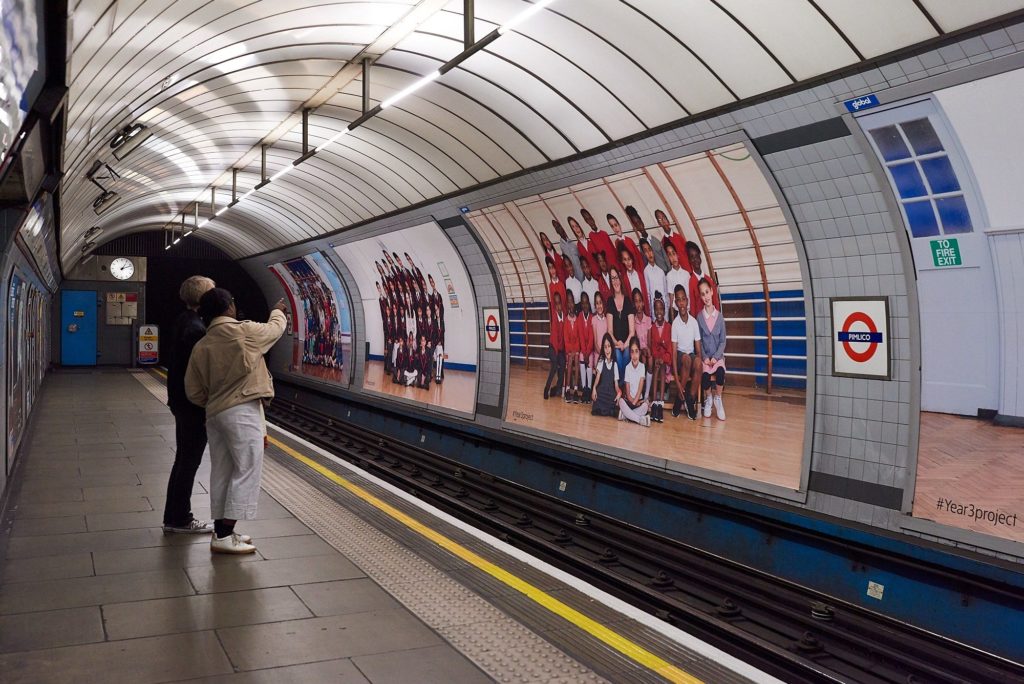I increasingly get the feeling that the two London Tates are struggling to know what to do with the huge central spaces that are a characteristic feature of both buildings. The new show at Tate Britain – Steve McQueen: Year 3 – is symptomatic of this, though it is in many ways a more successful solution to the problem than some of the previous ones.
This show is an admirable event – to the point maybe of being a little too self-admiring – ELS
The press handout describes it as “one of the most ambitious visual portraits of citizenship ever undertaken in one of the world’s largest cities”. The medium of expression is traditional class photographs made during the past year at London’s primary schools. The result is 3,128 of these images “depicting two-thirds of the city’s seven-to-eight-year-olds… brought together in a large-scale installation… and free for all to visit.”
There will also be, for a much briefer period a series of billboards carrying a selection of these group photographs on sites spanning all of London’s 33 boroughs. Some of these are on view at Pimlico underground station, the nearest stop on the underground to Tate Modern. “It is estimated that almost 7 million people will see one of the 613 Year 3 billboards.”
As the handout boasts: “Together, these two exhibitions form a celebration of the young people who will make `London their own in years to come and a meditation on the social forces and personal changes that shape all our lives.”

Change a few details, and what does this sound like? Yes, like a document from the most orthodox period of Soviet Russian Socialist Realist art.
To do the organisers justice, I don’t think this has been their conscious intention. Though the exhibition handout carries as part of its heading the phrase ‘a new direction’, the event shows an institution struggling to escape from an increasingly familiar trap, which is that art, to be contemporary, must constantly struggle to make its audience see the world anew. There a no visual shocks here. No radical ways of seeing. The school photograph – kiddies in rows, with maybe a few adult teachers added to the mix – is a time-worn image. Not as old as photography itself, but relatively venerable none the less. If you present these not-enormous images in rows, with the top line very close to the high ceiling of Tate Britain’s cathedral-like central space, you make it impossible for the audience to focus on any particular personality, any individual face. The exhibition is a complete artefact. It enfolds the spectator completely, which forbidding them to focus on any detail.
The publicity offers various quotations from the participants that seem to contradict this. For example, this: [Pupil from Bowed Primary, Enfield, “I was excited to find out that our picture was going to be in Tate Britain for everyone to see like we were a celebrity or piece of artwork.”
Or this: [Pupil from Little Ealing Primary, Ealing], “I think it’s amazing that my picture was used to promote the exhibition. It made me feel like the luckiest girl in the world. My family are so proud.”
In however sweet and innocent a fashion, ego will out. But the totality of the show contradicts these reactions.
What the exhibition really demonstrates is two striking contradictory things. One is that what calls itself ‘contemporary art’ is more and more, in official spaces like this one, about conscious declarations of civic virtue. The other is that visual creativity gets in the way.
This show is an admirable event – to the point maybe of being a little too self-admiring. As for trying to change the way you look at the world surrounding you, forget it. Its organisers don’t think that this is something it needs to attempt.
Words: Edward Lucie-Smith © Artlyst 2019 Photos Courtesy Tate Britain
Visit Steve McQueen @ Tate Britain

